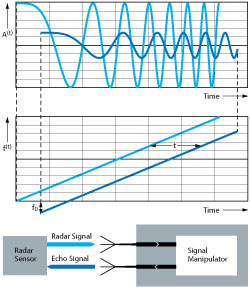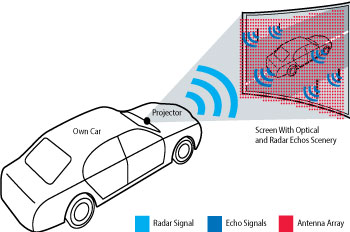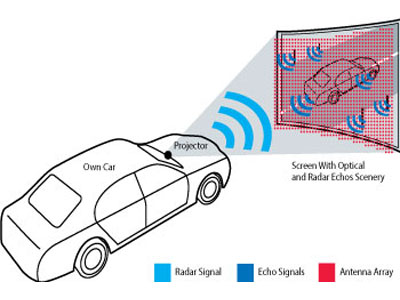The Future of Automotive Radar Testing with Radar Echo Generators
Steffen Heuel and Sherif Ahmed, Rohde & Schwarz, Munich, Germany
Automotive radar sensors are safety-relevant and have to be comprehensively tested to ensure reliable functioning. As radar performance, functionality and usage increases, test procedures have to become smarter to eliminate millions of kilometers of drive tests. This article addresses today’s radar measurement procedures for functional testing and outlines ideas and essential requirements for future test approaches.
As driving automation moves towards autonomy levels 4 and 5, radars are playing a significant role in complementing other sensor platforms to assure practically all-weather 360° vision capability. In many advanced vehicle designs, several radar units are located around the vehicle to complete the field of view and to allow low-range to high-range coverage up to a few hundred meters. At the same time, the semiconductor industry is progressing rapidly towards multi-static radar operation with antenna arrays consisting of tens of transmit and receive antennas. Some manufacturers are migrating to an all-CMOS design or mixed signal SiGe architecture in order to integrate the digital chain into the radar chip. As a result, radar solutions for ADAS functions and later for autonomous driving have become a cost-effective, irreplaceable solution. Additionally, machine-learning techniques are typically used to facilitate the sensor fusion decision-making process for maneuvering the vehicle in real-time on the street. Several worldwide leaders in the digital processing business are working to achieve highly efficient processors adapted to machine learning requirements, for deep learning algorithms for instance. Some processors are based on a GPU architecture, parallelized CPUs or even on dedicated controller units with direct sensor interfaces.
Automotive Radar Test Challenges
Radar sensors are unique in their ability to measure range, radial velocity, azimuth angle and size of objects by evaluating the echo signals in the observation area in terms of time delay, Doppler shift, angle of arrival and amplitude, respectively. Some modern radar sensors can also estimate the elevation angle and the next generation should provide true measurement of the elevation angle. Determining these parameters simultaneously and in complex multiple object environments, such as intersection scenarios, poses technical challenges for the radar design. To accomplish this, radars need to deliver high-resolution data, a fact that has encouraged many contributors to report on imaging radars or to seek synthetic aperture methods to enhance the radar data. All these requirements place stringent demands on the validation and verification of each radar unit or sensor system to ensure the expected performance.
Due to the increasing complexity and intelligence of radars, it is not sufficient to use direct evaluation of the radar signal quality to judge its performance on the street. Beyond conventional testing of its signal phase noise, Doppler resolution, phase reproducibility, temperature stability, output power, receiver noise figure, chirp slope and linearity, it is becoming necessary to test the function of the complete unit. The influences caused by integrating the radar inside the vehicle itself, e.g. internal reflections of the housing and radome (emblem or bumper) add to this complexity and degrade performance. Consequently, functional testing is becoming a mandatory step for approval by many premium car manufacturers.
Automotive Radar Solutions
Today, the simplest functional test relies on a corner reflector mounted in front of the radar at a specific reference distance. For a stable and reproducible test environment, a large anechoic chamber, such as the R&S ATS1000, is usually needed to suppress any unknown environmental conditions. While this sounds simple, this setup is actually only capable of testing the detection threshold at a given SNR level for a stationary idealistic target. It is not possible to test Doppler resolution and the dynamic behavior of a target, for example to verify tracking and classification processes. It is therefore essential to have a more realistic setup to mimic real-life situations. It is also necessary to include simulated foreign signals from radars of other moving cars to ensure interference mitigation.
Newer on the market are dedicated radar echo generators, such as the R&S AREG100A, that can manipulate the radar-transmitted signal in real-time in order to impose time delay, Doppler shift and attenuation before retransmitting the captured signal back towards the radar under test. A typical implementation would be receiving the radar RF signal and down-converting it to an intermediate frequency, where a time delay (range), radial velocity (Doppler shift) and attenuation (RCS) are introduced. The manipulated signal is then phase coherently up-converted to the RF and retransmitted to the radar under test. The radar under test receives and processes this modified version of the signal it originally transmitted and reports the detected range, Doppler shift and RCS.
Analog and digital radar echo generators both follow the same concept, but they may manipulate the radar echo signal differently. While analog echo generators use delay lines, e.g., waveguides, coaxial or over fiber optics, in order to delay the signal to a fixed distance, digital solutions have more flexibility in also dynamically changing the range through programmable time delays. A critical parameter in the digital solution is, however, the latency caused by the associated signal processing. Converting the radar waveform from the analog into the digital domain requires at least several digital clock cycles. Since the radar signal propagates at speed of light, each nanosecond of latency would correspond to a distance of approximately 15 cm, which cannot compensated for. While analog radar echo generators are used in verification tests and production lines, digital generators are more often used in research and development and have the potential to test more complex radar scenarios. Single radar echo generators can be used to validate the tracking algorithms for simple radial movements of targets. This would be the case in many Automatic Cruise Control (ACC) scenarios, for instance. To test functions such as lane change assist, the target azimuth angle must be varied and hence the angle of arrival needs to be simulated through the simulator frontend.
Future Testing Methods
Automotive radar development cycles are decreasing due to the tremendous demand resulting from highly automated driving. Radar performance, functionality and applications are all increasing. As the number of applications grows, the scenarios in which the application and ultimately the radar sensor have to be tested increase accordingly.
Today, a million test kilometers have to be driven before a function can claim to be validated. Considering all the new sensors and new cars every year, it is impossible to keep up with drive tests. In addition, decision networks that have been trained with data from “older sensors” may not be valid anymore because the training data and classification algorithms depend on the sensor itself. This means, a new sensor requires a new training and test data set, which means another million test kilometers. Since future production cars will be highly automated and fully autonomous, we need to find ways to reduce the required kilometers of drive tests. For legacy cars, vehicle in the loop (VeHIL) test rigs are available. But for newer production cars that rely on radar sensor information, these test rigs have to be updated with additional test equipment.

Figure 3 State-of-the-art radar echo generator principle.
In many cases, a car on a test rig will not even accelerate before the radar is manipulated. Radar echo generators and simulation of radar sensor echoes via electronic control unit (ECU) interfaces are a good starting point. While software simulation of radar sensors can be comprehensive and fulfill many demands, it does not really replicate the radar’s real-life behavior. Radar echo generators, on the other hand, test the radar and simulate range, Doppler and azimuth. At the present time, however, radar echo generators are not able to generate realistic scenarios for many azimuth and elevation angles that a sensor detects in a normal environment. This is because radar echo generators have a limited number of transmit and receive antennas and therefore cannot simulate a varying angular direction for the radar sensor under test (see Figure 3). As already indicated, this is sufficient for simple functional tests or performance tests such as accuracy, detection threshold or resolution, but definitely not for functional testing of advanced driver assist systems and autonomous vehicles.
A radar echo generator may require hundreds of receivers and emitters to capture, manipulate and retransmit echo signals that are as realistic as typical radar echo signatures. Besides the angular limitation, today’s radar echo generators also cannot simulate distributed targets (known as cloud targets). Pedestrians do not appear as a single reflection. They have multiple reflection points and the torso, legs and arms have different velocities. Vehicles do not appear as a single scatter point, but have distributed scatter points in range and azimuth with mainly a single Doppler component. All these requirements have to be taken into account when generating the realistic radar echo signals needed to test tracking, classification and decision processes from a scenario and functional point of view.

Figure 4 Future radar echo generator principle.
Figure 4 shows a concept where a radar echo generator consisting of an antenna array is mounted behind a screen. The screen shows a driving scenario, for example a highway scenario, for the camera sensor that supports the driver assist system.
A completely electronically controllable antenna array with thousands of emitters with a digital processing backend could be used to stimulate a radar sensor with complex targets and their maneuvers. The sensor is positioned in front of the measurement system, which receives the radar transmit signal, manipulates the range, Doppler, RCS in real-time and routes the echo signals to a specific antenna inside the antenna array, resulting in an azimuth and elevation angle for the radar under test. The beauty of this modular approach is that the reflection of the echo signal would be just like in real life. Large antenna arrays in this frequency range exist and can be used for radar testing, but there is presently no commercial radar echo generation solution available that can generate complex point cloud targets from such an antenna array.
Testing autonomous vehicles with their increasing amount of radar sensors, different operational modes, and sensor functionalities, will be more complex in future. To address these challenges, radar echo generators with single transmit and receive antennas are a good approach, but do not completely fulfill the requirements of future radar sensors and scenario testing. An antenna array in combination with a digital radar echo generator would have the capabilities to address the needs of testing radar sensors more realistically. Since research and development on autonomous cars, the scenarios to be tested, radar sensors and their fusion with other sensors such as laser scanners and cameras continues, OEMs, Tier 1’s and test and measurement manufacturers have to work hand-in-hand to provide solutions for the growing demands.

